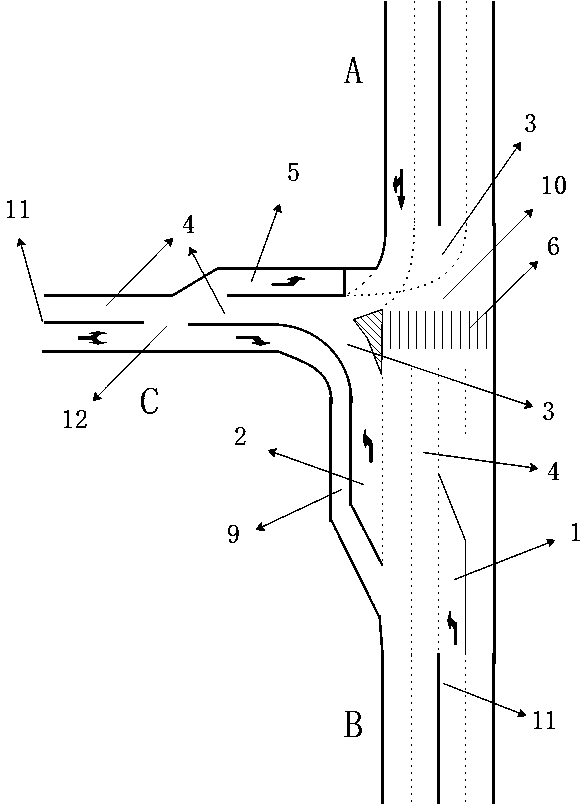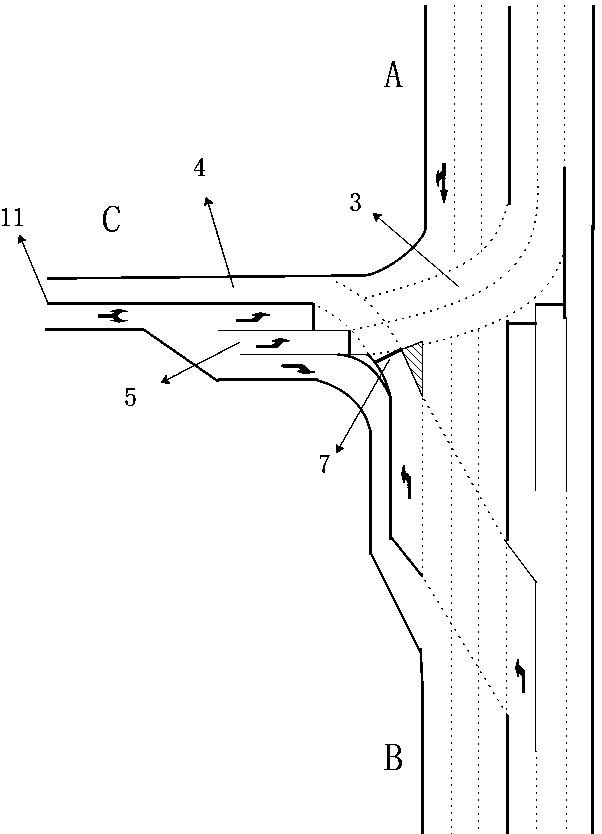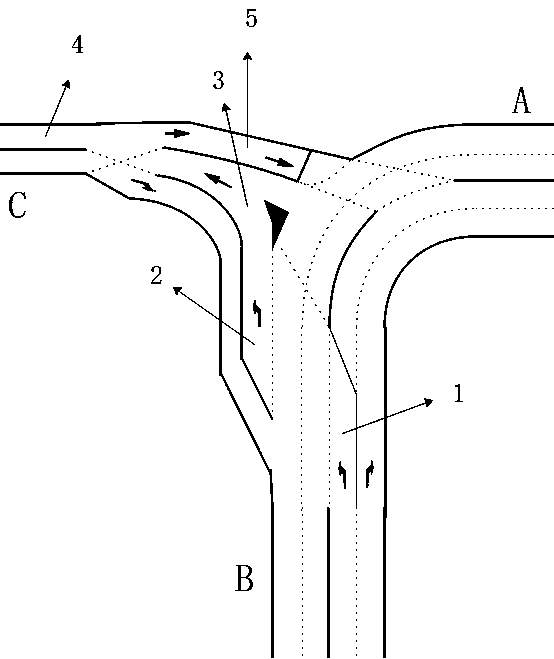Three-way intersection adopting batch lane changing method and control method thereof
A three-way intersection and road technology, applied in the field of transportation, can solve problems such as large delays, low traffic capacity, and large land occupation
- Summary
- Abstract
- Description
- Claims
- Application Information
AI Technical Summary
Problems solved by technology
Method used
Image
Examples
Embodiment 11
[0044] The three-fork intersection is formed by the intersection of A, B, and C roads. A, B are straight roads, and C road is a turning road. Vehicles on road B turn left to reach road C, and vehicles on road C turn left to reach road A. Vehicles traveling from road B to road C need to cross the A to B side of the A / B road. A and B are the main traffic, respectively two-way 4-lane; C road is a secondary road, two-way 2-lane. This is the most common three-fork intersection, also known as a T-junction.
[0045] A road establishes left-turn lane 3, and described C road establishes the waiting area 5 leading to A road as a left-turn waiting area, and the exit of the left-turn waiting area is connected to A road left-turn lane.
[0046] like figure 1 As shown, Road B is the entrance and exit for changing lanes in batches. The waiting area 1 leading to Road C is set at the entrance of Road B as a left-turn waiting area. Turning lane 3, the reverse lane of Road B connects to the l...
Embodiment 12
[0049] A and C are straight roads, vehicles on road A turn left to reach road B, and vehicles on road B turn left to reach road C, such as image 3 As shown, A and B are the main traffic, which is an intersection where the main traffic turns.
[0050] Road B adopts entrances and exits that change lanes in batches, and the entrance of Road B is set up to waiting area 1 leading to Road C. This waiting area is a left-turn waiting area. There is a reverse lane 2 outside the exit lane 4 of Road B, and a left-turn lane 3 is set at the front end of the entrance of Road C. The reverse lane of Road B connects with the left-turn lane 3 of Road C, and then connects to the exit lane 4 of Road C. Road C is provided with a waiting area 5 leading to Road A and a signal light leading to Road A. The waiting area is a straight waiting area, and the waiting area is located outside the exit lane 4 of Road C.
[0051] The three-fork intersection is controlled by two phases. The first phase is the...
Embodiment 13
[0054] Roads A, B, and C intersect at the three-fork intersection. Vehicles on road C turn left and arrive at road A, and vehicles on road A turn left and then arrive at road B. B and C are straight roads, such as Figure 4 As shown, A and B are the main traffic, and B and C form the straight road, which is a turning intersection of the main traffic.
[0055] Road B is the entrance and exit for changing lanes in batches. The waiting area 1 leading to Road C is set at the entrance of Road B and is a straight waiting area. The waiting area 5 leading to the A road in the C road is a left-turn waiting area, and the left-turn waiting area is located on the outside of the exit lane. There is a left-turn lane at the entrance of Road C, and the reverse lane of Road B connects to the left-turn lane of Road C.
[0056] In the second phase, the vehicles in the straight waiting area of Road B enter the reverse lane 2 by changing lanes in batches, and then enter the exit lane 4 of Road...
PUM
 Login to View More
Login to View More Abstract
Description
Claims
Application Information
 Login to View More
Login to View More - R&D
- Intellectual Property
- Life Sciences
- Materials
- Tech Scout
- Unparalleled Data Quality
- Higher Quality Content
- 60% Fewer Hallucinations
Browse by: Latest US Patents, China's latest patents, Technical Efficacy Thesaurus, Application Domain, Technology Topic, Popular Technical Reports.
© 2025 PatSnap. All rights reserved.Legal|Privacy policy|Modern Slavery Act Transparency Statement|Sitemap|About US| Contact US: help@patsnap.com



